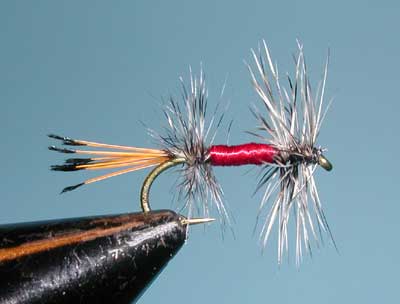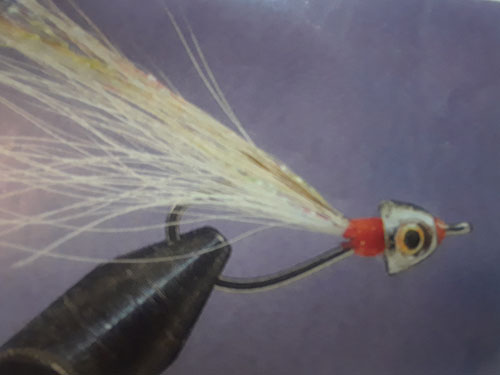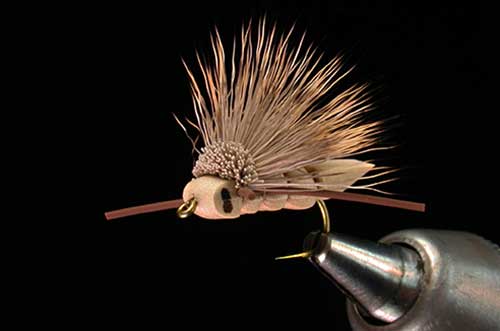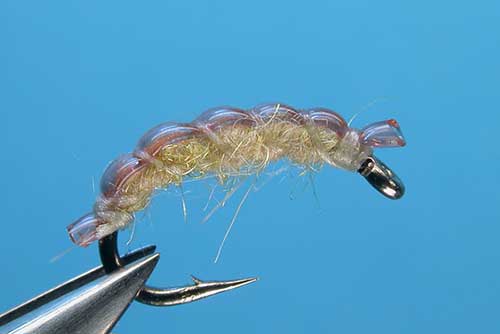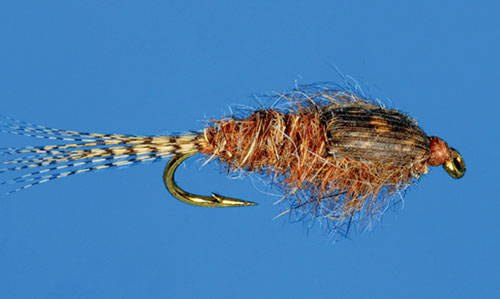Meat Whistle
John Barr

Translated by Carl Wuebben
CHARLIE CRAVEN (www.charliesflyboxinc.com)
This is John Barr’s Meat Whistle a pattern he developed for bass fishing in Colorado to replicate the pig n’ jig used by conventional tackle anglers. John is one incredibly creative guy and coupled marabou and rabbit strips with a Gamakatsu jig hook to craft a fly rod worthy comparison. In the time since John hatched the Meat Whistle concept he, and the rest of the world, have found that this pattern is equally effective on trout in both still and moving water. While a great imitation of a crayfish, the Meat Whistle can be tied in a variety of colors and sizes to imitate small baitfish as well. The unique jig hook application makes for a pattern that can be stripped quickly or hopped and dropped much more slowly. It seems to me that the key to fishing this fly is to keep it slow. Tie a few of these up and try them- they work, just remember … slow is better!
PATTERN
CONE – Large tungsten copper cone
THREAD – UTC 140 denier (6/0), rusty brown
RIBBING – Brassie sized UTC Ultra wire, copper brown
BODY – Copper sparkle braid
WING – Rusty brown rabbit strip
LEGS – Pumpkin barred sili legs
FLASH –Copper flashabou
COLLER –Brown marabou
HOW TO TIE
- Place the cone on the hook and place the hook in the vise with the point down. Start your thread in at about a quarter shank length back from the back edge of the cone and wrap a smooth thread base to the bend of the hook. Return the thread back to the starting point keeping close smooth wraps
- Tie in the copper braid and wire at the same time at the back of the cone (facing rearward) and wrap back over the braid and wire to the bend of the hook. Return the thread to the front again.
- Wrap the braid only forward from the bend creating a slender body. Tie off the braid and clip the tag end off.
- Remove the hook and turn it upside down and place it back in the vise.
- Clip a hunk of rabbit hide a little bit longer than 2 hook lengths then pierce the strip with the hook point right in the center of the strip. Make sure there is enough length for the strip to reach from the bend to the front of the hook. Pull the hook through the hide and slide the strip down to the base of the body at the rear of the hook. This entails removing the hook from the vise to butt the strip up to the back of the body then remounting it again the same way (point up).
- Tie the front end of the rabbit strip down tightly at the front edge of the body (2 eyelets space behind the cone). Be careful not to build up too much bulk here. Clip the excess rabbit strip and cover the butt end with a smooth thread base. Using the end of the wire like a needle, thread the tip of the wire through the rabbit strip and holding the hide down to the hook shank only, this keeps from binding down the rabbit hair like a Matuka style wing. Continue ribbing the wire forward at evenly spaced intervals through the wing/body assembly. Once at the front of the body, wrap the wire around the shank two times and tie off with the thread. Clip the excess wire flush.
- Turn the hook over in the vise once again. Be careful as the hook point is very sharp (use a #2 pencil eraser to cover the hook point) now wet your fingers and pet the rabbit hair rearward to get it out of the way.
- Double over two strands of sili-legs onto your thread and tie them in over the shank at the front edge of the body (behind the cone and on top with the rabbit strip) with a few thread wraps and keeping them off to the side, butt on the top (2 on each topside) you should now have two legs on each side of the fly. Place the long ends of the sili-legs into your material spring to keep them out of the way.
- Cut a small clump of flashabou from the hank and tie it in behind the cone at the center of its length. The flash should extend about a half-inch past the hook bend. Work the flash all the way around the shank with your finger so it is evenly distributed 360 degrees around the shank. Push back the long ends toward the rear of the hook and bind all the flash in place with several tight turns to keep them in place.
- Select and measure a marabou feather so the tips reach back just past the bend of the hook. Tie the marabou feather down at the back edge of the cone on top of the hook shank. Try to spread the feather out so it encompasses the top half of the shank. Do not cut the butt end of the marabou yet. Invert the hook and tie in another marabou feather on the bottom of the shank equaling the length of the first. Clip the butt ends of the marabou as close to the shank as possible. It is imperative to keep a clean tie down here to eliminate bulk. Cover the butt ends with a few tight, smooth wraps of thread. Now whip finish and clip off the thread and put a little head cement on the thread wraps.
- Shove the cone back up against the butt ends of the marabou collar as tightly as possible then retie in your thread in at the front of the cone and build up a tapered thread base matching the taper of the front of the cone. Whip finish and clip the thread, add a drop of five-minute epoxy or clear cure goo (UV glue) on the thread wraps at the front of the cone. Coat all the thread wraps as well as the whole cone with a light, thin layer of epoxy to protect it from coming undone.
TIE UP A DOZEN OR TWO – AND GO FISHING*** But remember to practice C.P.R. (CATCH – PICTURE – RELEASE)

